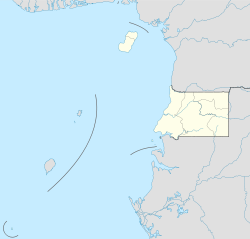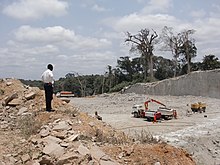Ciudad de la Paz
| Ciudad de la Paz | ||
|---|---|---|
|
|
||
| Coordinates | 1 ° 43 ' N , 10 ° 43' E | |
| Basic data | ||
| Country | Equatorial Guinea | |
| Continental region | ||
| province | Wele-Nzas | |
| ISO 3166-2 | GQ-WN | |
| height | 454 m | |
| The city is under construction. It has been the seat of government in Equatorial Guinea since 2017. | ||
|
Construction sign on the Rio Wele (2010)
|
||
Ciudad de la Paz , until 2017 Oyala (also: Djibloho ) is a planned city in Equatorial Guinea , which has been the country's new seat of government since February 2017.
location
The city is being built on the Rio Wele in the hinterland of Equatorial Guinea, 180 km east-southeast of the port city of Bata and 78 km north of Bidjabidjan in the Wele-Nzas province . It is 454 m above sea level.
Planning and construction
The government is planning and building a new city as the seat of government in the middle of the undeveloped jungle . It is to become the official seat of the president, government, administration, police and military leadership and thus replace the current capital Malabo . In Ciudad de la Paz, 160,000 to 200,000 people will later be able to live on an area of 81.5 km². That corresponds to about a quarter of the equatorial Guinean population; the exact number of inhabitants is not known.
A golf course, a university and a luxury hotel as well as six-lane highways were almost finished in 2013. The government palace and a large basilica were completed in 2019. A financial district and housing developments are in planning. In 2010 only three “inner-city” bridges and several motorways were partially finished or under construction (see picture on the left). They are intended to connect the city with the new airport at Mengomeyén (the home of the president) and develop the strategic importance of the port city of Bata for neighboring Gabon and all of Central Africa . Huge jungle areas were cleared for the highways and aisles were blown into the granite hills (see picture). The Portuguese Chamber of Commerce (AICEP) said the city should use renewable energy and be sustainable. The energy supply is ensured by the Djibloho dam, which dams the Wele river.
Financing is provided by AICEP. The plans come from a Portuguese architecture firm. A report by the BBC suspects costs of several billions. The city should be completed by 2020. The construction work is supported from Poland, Brazil and North Korea. Construction delays allegedly occur again and again because President Obiang has buildings demolished whose view he does not like. In addition, all building materials are imported.
In February 2017, the government moved its headquarters from Malabo to the still unfinished city in order to give new impetus to the development of the region. The government has been relocated to cities on the mainland several times (mainly Bata ), each time leading to administrative problems.
Criticism of the construction project
The project of a new capital is attributed to dictator Teodoro Obiang Nguema Mbasogo's obsessive fear of riots and attacks. In addition, one of his sons, Vice President Teodoro Obiang Nguema Mangue , is benefiting from the project, whose construction company Abayak has a monopoly on the country's cement market. Since the broader population does not benefit from the country's actually immense wealth ( oil , natural gas ), the plan is criticized in the international press and by the Equatorial Guinean opposition. In addition, the need for such a large city deep inland is questionable because a large part of the population lives by the sea. The city's sustainability, which the Portuguese Chamber of Commerce emphasizes, may not match the jungle clearing.
See also
Individual evidence
- ↑ a b c d e f Boas Notícias: Atelier luso desenha futura capital da Guiné Equatorial , published November 5, 2011, accessed February 5, 2013
- ↑ According to TrueKnowledge
- ↑ Geographical coordinates
- ↑ MapLandia: Oyala Map - Satellite Images of Oyala
- ↑ a b c d e f g h i ORF : A dream capital in the jungle of Africa, The Dictator's Dream , published and viewed on: February 4, 2013
- ↑ a b c d e f g h i j k Stephen Sackur: BBC News: Equatorial Guinea: Obiang's future capital, Oyala. December 17, 2012, accessed February 5, 2013 .
- ↑ a b c ABC: Oyala, una nueva capital para la megalomanía de Obiang , published: December 26, 2012, viewed February 5, 2013
- ^ Government of Equatorial Guinea: Ver más datos de Guinea Ecuatorial. Guinea Ecuatorila en cifras (Evolución de la población de Guinea Ecuatorial). Retrieved February 5, 2013 .
- ↑ World Bank: Population, total. Retrieved February 5, 2013 .
- ^ Federal Foreign Office: Country Information. Equatorial Guinea. Retrieved February 5, 2013 .
- ^ CIA: The World Fact Book Online. Retrieved February 5, 2013 .
- ↑ The largest construction site in Africa: The new capital Oyala is being built here watson.ch , February 4, 2015, accessed on June 28, 2020
- ↑ http://www.archdaily.com/tag/idf-ideias-do-futuro/
- ↑ El Gobierno de Guinea Ecuatorial se muda de Malabo A Oyala guineainfomarket.com , February 11, 2017 (Spanish)
- ↑ Tom Collins: Flashy façade hides abuse, poverty mg.co.za , September 27, 2019 (English)




